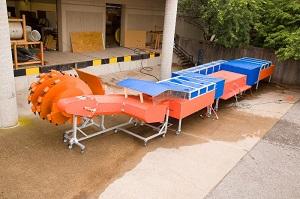Researchers at the University of Kentucky have unveiled longwall shearers that also have scrubber systems attached to them which minimize the amount of coal exposure to miners. Shearers extract coal from coalfaces and according to the researchers account for 50% of all the coal produced in the world today.
Thomas Novak and Chad Wedding work with the University of Kentucky Department of Mining Engineering Alliance Coal. Novak said that mining operations, unlike longwall mining, have used what are called flooded bed scrubbers in the industry. What their study consists of is bringing mining technology from one kind of engineering to

another kind of engineering to minimize the amount of dust that is produced by longwall shearing. So they set out to implement scrubbers into a longwall shearer.
The researchers have 3D printed molds for the scrubber parts of the longwall shearer and the rest of the shearer was built in University of Kentucky’s “machine shop”.
Upon completing a prototype 3D printed small-scale version of the shearer, the researchers are confident they can print a full 65-foot full-scale model. The model will have to go through a round of safety tests to measure whether or not the shearer is ready to be put to work. The researchers could set a new precedent for 3D printing parts for mining efforts.
An Australia mine is also getting their own longwall mining system from Caterpillar. The Moolarbean Coal Complex will receive the machine and will start extracting coal in the New South Wales area. This, after a string of other longwall systems proved their efficiency elsewhere in Australia. What makes the specific longwall system special is that it can be controlled by “advanced automation control”. The newer technology includes Horizon Control, Extraction Control and Face Alignment which all contribute to more efficient coal extraction. The system is said to be in operation by 2017.
To see how CAT longwall systems work, check the video below:
Source: Mining Technology / Engineer Live


